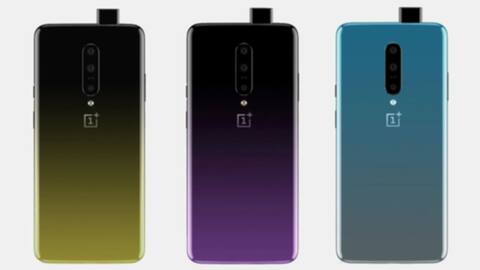OnePlus 7 looks primed to dwarf the OnePlus 6T
What's the story
Going by the persistent stream of leaks, OnePlus has taken a brave but potentially dangerous move, to adopt a pop-up selfie camera on its upcoming flagship, the OnePlus 7.
But moving past the debatable design, the phone looks primed to dwarf the OnePlus 6T if one goes by the specifications leaked in a new introduction video.
Here's how OnePlus 7 will outperform OnePlus 6T.
Design & display
Dropping the notch for a pop-up camera
We've had countless OnePlus 7 leaks and renders that confirm the presence of an all-screen design achieved by adopting a pop-up selfie camera.
This design should offer a significantly higher screen-to-body ratio of over 90% as against a nearly 86% screen area on the OnePlus 6T.
Other notable changes include a larger earpiece, re-positioned alert slider, triple rear-camera setup, and new gradient colors.
Camera
OnePlus 7's triple rear camera setup to include 48MP sensor
OnePlus 7 will see an upgrade from 6T's dual-lens setup to a triple camera array.
As per the video, the setup will comprise a 48MP main sensor, a 20MP secondary sensor, and another 5MP depth sensor. Up front, the phone will offer a 16MP (f/1.9) selfie snapper.
With this, OnePlus 7 will also be able to compete against flagships like S10 and iPhone 11.
Internals
Under the hood
Internally, OnePlus 7 will be an incremental update with the latest Qualcomm Snapdragon 855 chipset and upto 12GB RAM option, as claimed by the leaker.
Interestingly, it is also said to house a bigger 4,000mAh battery and support fast 44W Dash Charging - a major upgrade over OnePlus 6T's 3,700mAh battery and 20W fast-charging.
Lastly, we know that the phone won't support wireless charging.
Cost of flagship
Pricing: Expect an uptick over OnePlus 6T's price tag
OnePlus 6T has outshined competitors with its successful mix of premium design, flagship performance, and an affordable price tag.
But given the design makeover, camera upgrade, and internal increment, OnePlus 7 might see an uptick of $50-100 over OnePlus 6T.
That said, the phone is sure to attract masses as it will still cost $300-400 less than a $1,000 Galaxy S10 or iPhone 11.
